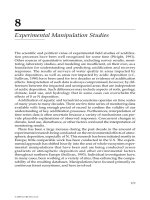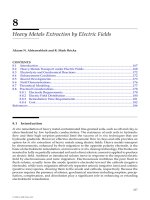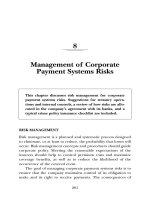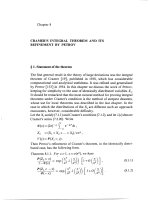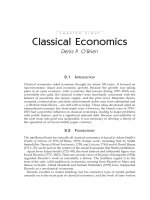Survey of accounting 6e chapter 8
Bạn đang xem bản rút gọn của tài liệu. Xem và tải ngay bản đầy đủ của tài liệu tại đây (2.21 MB, 45 trang )
Liabilities and Stockholders’
Equity
Chapter
8
©2013 Cengage Learning. All Rights Reserved. May not be scanned, copied or duplicated, or posted to a publically accessible website, in whole or in part.
Learning Objectives
After studying this chapter, you should be able to:
•
Describe how businesses finance their operations.
•
Describe and illustrate current liabilities, notes payable, taxes,
contingencies, and payroll.
•
Describe and illustrate the financing of operations through
issuance of bonds.
•
Describe and illustrate the financing of operations through
issuance of stock.
•
Describe and illustrate the accounting for cash and stock
dividends.
•
Describe the effects of stock splits on the financial statements.
•
Describe financial statement reporting of liabilities and
stockholders’ equity.
•
Analyze the impact of debt or equity financing on earnings per
share.
©2013 Cengage Learning. All Rights Reserved. May not be scanned, copied or duplicated, or posted to a publically accessible website, in whole or in part.
Learning
Objective 1
Describe how businesses finance
their operations
©2013 Cengage Learning. All Rights Reserved. May not be scanned, copied or duplicated, or posted to a publically accessible website, in whole or in part.
Financing Operations
Businesses must finance operations through one of
the two ways:
• Debt Financing – includes all ___________.
• Equity Financing – includes _____________
________________________.
©2013 Cengage Learning. All Rights Reserved. May not be scanned, copied or duplicated, or posted to a publically accessible website, in whole or in part.
Learning
Objective 2
Describe and illustrate current liabilities,
notes payable, taxes, contingencies, and
payroll
©2013 Cengage Learning. All Rights Reserved. May not be scanned, copied or duplicated, or posted to a publically accessible website, in whole or in part.
Liabilities
•
•
•
•
Debts owed to others
Current liabilities – due ________
Long-term liabilities – due _________
Some liabilities are contingent on the outcome of
future events.
©2013 Cengage Learning. All Rights Reserved. May not be scanned, copied or duplicated, or posted to a publically accessible website, in whole or in part.
Notes Payable
• Longer and more formal than accounts payable
• Usually bear interest
• Issued to ___________ when merchandise or other
assets are purchased
©2013 Cengage Learning. All Rights Reserved. May not be scanned, copied or duplicated, or posted to a publically accessible website, in whole or in part.
Assume that a business issues a 90-day, 6%
note for $1,000, dated August 1, 2012 to
satisfy an account payable
©2013 Cengage Learning. All Rights Reserved. May not be scanned, copied or duplicated, or posted to a publically accessible website, in whole or in part.
Income Taxes
• Includes _________ and possibly _______
• Most corporations are required to pay federal
income taxes in _______ installments throughout
the year.
©2013 Cengage Learning. All Rights Reserved. May not be scanned, copied or duplicated, or posted to a publically accessible website, in whole or in part.
Taxable Income vs. Income
Before Taxes
• Taxable Income – determined according _________
• Income Before Taxes – determined according to
___________________________
• Differences between the two may need to be
allocated between various financial statement
periods
Exhibit 1: Taxable Income and Income Before Taxes
_________
___________________________
©2013 Cengage Learning. All Rights Reserved. May not be scanned, copied or duplicated, or posted to a publically accessible website, in whole or in part.
Accounting for Temporary
Differences
©2013 Cengage Learning. All Rights Reserved. May not be scanned, copied or duplicated, or posted to a publically accessible website, in whole or in part.
Contingent Liabilities
©2013 Cengage Learning. All Rights Reserved. May not be scanned, copied or duplicated, or posted to a publically accessible website, in whole or in part.
Payroll
• The amount paid to _______ for services they provide
during a period
• Salary – payment for ___________
• Wages – payment for ___________
• Payroll and related taxes significantly impact the net
income of most businesses
©2013 Cengage Learning. All Rights Reserved. May not be scanned, copied or duplicated, or posted to a publically accessible website, in whole or in part.
Recording Payroll
©2013 Cengage Learning. All Rights Reserved. May not be scanned, copied or duplicated, or posted to a publically accessible website, in whole or in part.
Payroll Taxes
Employer Taxes
Employee Taxes
• _____
• ______________
______________
• ________
• ______________
___________
Payroll taxes become a ___________ when the
related payroll is paid to employees. The ________
is relieved when the taxes are paid to the
appropriate agencies.
©2013 Cengage Learning. All Rights Reserved. May not be scanned, copied or duplicated, or posted to a publically accessible website, in whole or in part.
Learning
Objective 3
Describe and illustrate the financing of
operations through issuance of bonds
©2013 Cengage Learning. All Rights Reserved. May not be scanned, copied or duplicated, or posted to a publically accessible website, in whole or in part.
Bonds
• A form of _______-bearing note
• Bonds include ______ that must be paid on a
regular basis
• Bonds face value must be repaid at _____.
• Bond indenture – contract between the __________
and the __________
• A bond issue is normally divided into several
individual bonds. The most common face value is
$1,000 per bond.
©2013 Cengage Learning. All Rights Reserved. May not be scanned, copied or duplicated, or posted to a publically accessible website, in whole or in part.
Calculating the Bond Issue
Price
• The price that buyers are willing to pay for the bonds
depends on three factors:
• The _______ of the bonds due at the maturity
date.
• The _______ to be paid on the bonds – stated
in the bond indenture. This is called the
____________.
• The market (effective) rate of interest
©2013 Cengage Learning. All Rights Reserved. May not be scanned, copied or duplicated, or posted to a publically accessible website, in whole or in part.
Recording Bond Issuance
Assume that a business issues $100,000 of 6%, 5year bonds, with interest of $3,000 payable
semiannually. The market rate of interest at the
time the bonds are issued is 6%.
Issuance of bonds payable at face amount on January 1.
©2013 Cengage Learning. All Rights Reserved. May not be scanned, copied or duplicated, or posted to a publically accessible website, in whole or in part.
Additional Bond Entries
©2013 Cengage Learning. All Rights Reserved. May not be scanned, copied or duplicated, or posted to a publically accessible website, in whole or in part.
Bonds Not Issued at Face Value
• Discount on Bonds Payable
• Market rate of interest ______ contract rate
• Buyers are only willing to pay less than the
face value for the bonds
• Premium on Bonds Payable
• Market rate of interest ________ contract rate
• Buyers are willing to pay more than the face
value for the bonds
©2013 Cengage Learning. All Rights Reserved. May not be scanned, copied or duplicated, or posted to a publically accessible website, in whole or in part.
Learning
Objective 4
Describe and illustrate the financing of
operations through issuance of stock
©2013 Cengage Learning. All Rights Reserved. May not be scanned, copied or duplicated, or posted to a publically accessible website, in whole or in part.
Stock
• Major means of equity financing
• Shares
• Authorized – ___________
_______________________
• Issued – ______________
_______________________
• Outstanding – __________
_______________________
©2013 Cengage Learning. All Rights Reserved. May not be scanned, copied or duplicated, or posted to a publically accessible website, in whole or in part.
Shares of Stock
• Can be issued with or without assigning a monetary
amount:
• Par: __________________
• No-par: some states might require a stated
value
• Legal Capital
• ___________ stockholder contribution
required by some states
©2013 Cengage Learning. All Rights Reserved. May not be scanned, copied or duplicated, or posted to a publically accessible website, in whole or in part.
Stock Rights
• ________ in matters concerning the
corporation
• ________ in distributions of earnings
• ________ in assets on liquidation
©2013 Cengage Learning. All Rights Reserved. May not be scanned, copied or duplicated, or posted to a publically accessible website, in whole or in part.


